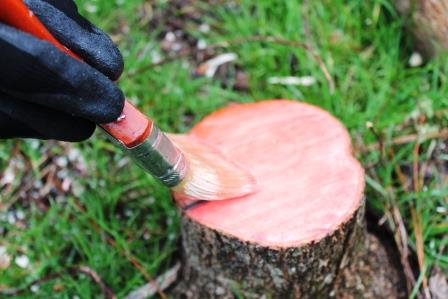
by Mark Mauldin | Feb 20, 2014
As Floridians we often struggle to find any upside to these cold, gray days we’ve been experiencing past few months. As “unfloridian” as our winters can be they pale in comparison to those endured by the more northern states. In fact, the last days of winter can be the ideal time of year in the Panhandle to tackle some outdoor chores like controlling unwanted trees and other woody plants.
Controlling trees can be hard work, the cooler temperatures can make the task a little less taxing. The relative inactivity of the “creepy crawlies” and pests often found in wooded areas is another reason to consider completing tree and woody plant removal projects during the winter.
Tree control generally involves mechanical removal. In some cases mechanical removal provides only short term control; in other cases it can actually increase the number of unwanted plants over time. This is the problem with both Chinese tallow (popcorn tree) and privet. Herbicide treatments can eliminate the possibility of regrowth and provide permanent control. The herbicide application techniques used to control trees and other woody plants are very selective and they are effective during the winter. These techniques provide opportunities to use herbicides in a controlled and very targeted manner with very little risk to surrounding plants. Additionally, the techniques below are most effective through the fall and winter when sap flow in trees is lessened.
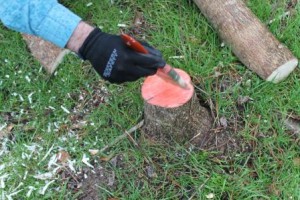
For best results the cut stump treatment should be done immediately after the tree has been cut down. Photo courtesy of Mark Mauldin.
The cut stump technique is a fairly common and very effective method of achieving permanent control of woody plants. As the name implies, the first step in the cut stump technique is to cut down the tree. Immediately after cutting down the tree spray or paint the stump with herbicide. On smaller stumps the entire surface should be covered with herbicide; on larger stumps effective control can be achieved by only covering the outside three inches of the stump.
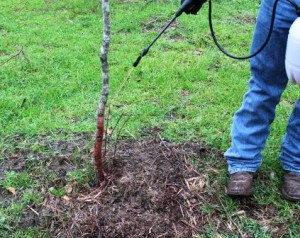
With the basal treatment, cover the bottom 12 to 18 inches of the tree with the herbicide oil mixture. Be sure to cover the entire circumference of the tree. Photo courtesy of Mark Mauldin.
Two additional herbicide application techniques that work well on woody plants do not require the plants to be cut down first. The basal application technique works best on smooth barked woody plants with a diameter of less than six inches. This technique involves spraying the bottom 12 to 18 inches of the tree with an herbicide oil mixture.
The hack and squirt method works well on large and/or thick barked trees. This technique involves using hatchet or other tool to cut through the bark around the circumference of the tree, then applying herbicide directly to the cut. Several months should pass between herbicide application using either of these techniques and mechanical removal.
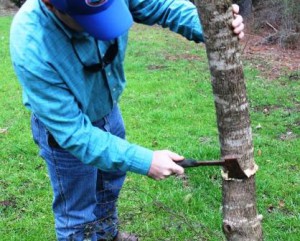
The hack and squirt treatment is best for large and/or thick barked trees. Photo courtesy of Mark Mauldin.
Be sure to read and follow the label of any herbicide you use. Always wear the proper personal protective equipment. For more information on the techniques described, including recommended herbicides and rates, read Herbicide Application Techniques for Woody Plant Control or contact your county’s UF/IFAS Extension Office.
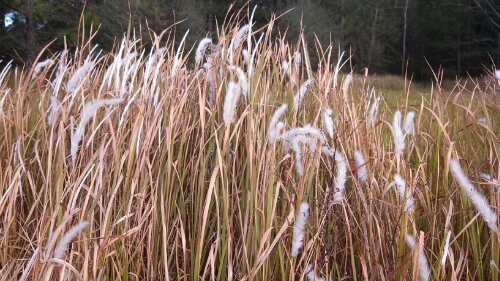
by Jennifer Bearden | Jan 3, 2014

Join us for a workshop on the biology and control of cogongrass.
January 14, 2014
Registration begins at 8:30am (Eastern Time)
Program starts at 9:00am (Eastern Time) and will end at 4:30pm (Eastern Time).
The cost of the workshop is $25 and includes lunch.
Locations:
Pensacola, Fl
Crestview, Fl
Chipley, Fl
Tallahassee, Fl

Please remember to specify which locations when calling to register and purchase the correct location ticket when registering online.
Pesticide CEUs have been requested. We are awaiting final approval and will update this post as soon as we have additional information. If you have questions please contact us at 850-606-5200.
AGENDA
Cogongrass in the Panhandle Workshop
9:00 – 9:50 AM – Overview, Biology and Control of Cogongrass – Dr Greg MacDonald, UF-IFAS Agronomy – Participants will learn what we currently know about the biology and control of cogongrass.
9:50 – 10:40 AM – “Safely Applying Right of Way Herbicides” – Jennifer Bearden & Sheila Dunning, UF-IFAS Extension Okaloosa County – Participants will learn pathways of herbicide efficacy, safety, label-reading, and PPE for common Right of Way Herbicides.
11:00-11:50 AM – Update: “Cogongrass Control in ROW, Forestry and Natural Areas – New Research, New Programs” – Participants will learn herbicide selections, application rates, timing and methods of control being researched and employed in the Southeast.
11:00 – 11:25 AM – “Imazapyr and Glyphosate Application Rate, Timing, and Methods for Cogongrass Control” – Dr Pat Minogue, UF-IFAS/NFREC Forestry
11:25 – 11:50 AM – “USFS/Five-State Forestry Agency Cogongrass Initiative” – Dr Jeff Eickwort, FDACS-Florida Forest Service
11:50 AM – 12:40 PM – “Cooperative Invasive Species Management in the Panhandle”
11:50 – 12:10 – “Breaking down Artificial Barriers to Allow Everyone to Cooperate” –
Brian Pelc, Natural Areas Restoration Specialist with The Nature Conservancy, and Invasive Species Coordinator for the Apalachicola National Forest, USFS
12:10 – 12:25 – A Regional Case Study from the Apalachicola CISMA (Cooperative Invasive Species Management Area) – Brian Pelc, Natural Areas Restoration Specialist with The Nature Conservancy and Invasive Species Coordinator for the Apalachicola National Forest, USFS
12:25 – 12:40 – A Regional Case Study from the Six Rivers CISMA – Brooke Saari, Sea Grant Extension Agent, UF/IFAS Extension in Okaloosa and Walton counties
12:40 – 1:30 PM – Lunch (catered-in at each host site)
1:30 – 2:30 PM – “Tools for Identifying, Tracking and Managing Cogongrass across the Landscape” – Participants will learn to use technologies available to identify, track and manage cogongrass infestations.
1:30 – 2:00 PM – “Monitoring Cogongrass Infestations with EDDMapS” – Jed Dillard, UFIFAS Extension Jefferson County
2:00 – 2:30 PM – “A Local Case Study from the City of Tallahassee”– Tony Murray, Coordinator of Environmental Regulation Compliance with City of Tallahassee Environmental Policy and Energy Resources/ Policy & Program Development
The following topics will be covered by Extension faculty at each site.
Okaloosa – Jennifer Bearden and Sheila Dunning
Washington – Mark Mauldin and Josh Thompson
Leon – Will Sheftall and Stan Rosenthal
Jefferson – Jed Dillard
2:30 – 2:55 PM – Cogongrass and Look-alikes ID – Participants will learn how to identify Cogongrass and some similar plants.
3:00 – 3:25 PM – Label Reading Exercise – Participants will learn to read herbicide labels and why it is important.
3:30 – 3:55 PM – Sprayer Calibration – Participants will learn methods to calibrate ATV and Backpack sprayer equipment.
4:00 – 4:25 PM – Personal Protective Equipment – Participants will learn proper equipment and why it is important.
4:25-4:30 PM – Evaluation






